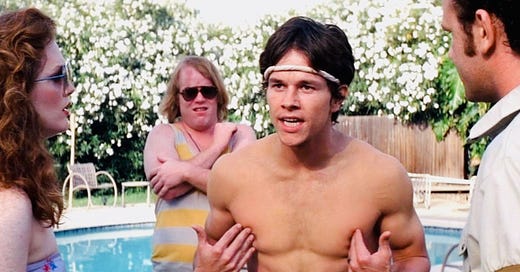Boogie Nights (1997, Paul Thomas Anderson)
Tuesday 15th of July, 6:45pm in the Richard Hoggart Building Cinema
Join us on Tuesday the 15th of July from 6:45pm (film starts at 7pm) in the Richard Hoggart Building Cinema for a screening of Paul Thomas Anderson’s second film, Boogie Nights (1997). The film is 2 hours 36 minutes long so the screening will finish around 9:40pm.
For his second film, Anderson once again used as his source material a previous short film he had made, The Dirk Diggler Story, a mockumentary from the late 80s about the rise and fall of a fictional male porn star around a decade earlier, the idea for which Anderson had originally conceived when he was only 17. A decade later, still only aged 27, he blew the original idea up into a vast, two-and-a-half-hour ensemble drama spanning the end of the so-called ‘Golden Age of Porn’ in the late 70s to the mid-80s, with the rise of cocaine and porn on VHS. The original idea was based on a 1981 documentary, Exhausted: John C. Holmes, The Real Story about the life of a famous porn actor, the first instance of Anderson’s recurring use of real life figures as the basis for fictional characters: the founder of Scientology L. Ron Hubbard in The Master, the Hollywood hairdresser Jon Peters in Licorice Pizza.
Boogie Nights tells the story of Eddie Adams (Mark Wahlberg), a young man who is spotted working in a nightclub by Jack Horner (Burt Reynolds), a porn director, who turns him into a star of the porn industry – a mixed blessing. Around these two central characters and the surrogate father relationship between them Anderson builds a social world, with a large supporting cast carrying a set of interwoven narratives, each shaped by the moment of historical transition through which they are living. Though they are on the outside of movie-making proper, these people nevertheless imagine what they do is near to it, and have dreams of making artistic work of lasting value.
Strongly influenced by the work of Robert Altman and especially Martin Scorsese, Boogie Nights bears comparison to the latter’s Goodfellas, at times even blatantly ripping off the latter: the bravura long opening shot taking us into and around the nightclub recalling Scorsese’s long shot following Henry and his wife Karen’s entry into the Copacabana. If there is a difference between these two shots, however, it is that in Boogie Nights the long shot is more character-motivated: the film camera itself is searching the nightclub, putting us in the same position – though we may not realise it – as Jack Horner, searching for his next star. And whereas Scorsese uses the long tracking shot sparingly, Anderson’s film is saturated with them, allowing characters and narratives to float in and out of the frame in big, set-piece scenes, de-centring the main characters to some degree and creating a more Altman-esque choral or ensemble narrative; a formal approach Anderson pushed even further in his next film, Magnolia (1999).
The affinities with Goodfellas go further: both immerse the viewer in a social world disavowed by and at odds with mainstream American society, with its own separate set of values and codes, a mini-society that creates its own status, hierarchy and meanings that have little currency in the world beyond them. More narrowly, both films depict – and at times absorb into their style – the impact of the arrival of cocaine in early 80s America. But it could be argued the influence of Scorsese’s film on Anderson’s was later returned: Boogie Nights is arguably one of the films to which The Wolf of Wall Street is most indebted. (One small irony of history: that film’s lead, Leonardo DiCaprio, was Anderson’s first choice to play Eddie Adams in Boogie Nights, but had to turn down the role because he was starring in Titanic. Anderson’s upcoming One Battle After Another is their first film together.)
Boogie Nights was received with critical acclaim, made Anderson’s name as a major new director to watch, and was nominated for three Academy Awards, including Best Screenplay. Perhaps now seen as a less significant than later works – less of a masterpiece than There Will Be Blood, more conventional than The Master – the film remains one of Anderson’s funniest, most entertaining and most rewatchable, but also represents a surprisingly deep and self-reflexive meditation on the arrival of the neoliberal era and cultural logic, which we now tend to label postmodernism.


